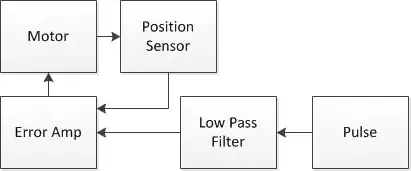A servo interprets a 1ms pulse as far left, a 1.5ms pulse as centre and a 2ms pulse as far right, usually. But what if there is no pulse? Will a servo hold its position if it is just commanded once and never commanded again for a few minutes?
-
I have been wondering somewhat the same thing, but I plan to remove all power. Still I suspect transients on shut down and start up may make it twitch. – russ_hensel Apr 15 '11 at 21:59
-
A worm gear mechanism can be effective for unidirectional power transmission at higher reduction ratios. – Dec 23 '15 at 17:01
4 Answers
It is very doubtful that it would stay in the same location.
The way I understand servo motors to work is that there is a constant feedback loop that is comparing the position to your pulse. Something like this:

To explain a bit more, the pulse is feed into what I called a low pass filter. It turns your pulse into a voltage that is in the range that the position sensor should also be outputting. It is also designed so that the voltage is maintained during your pulses 20ish ms off time. This voltage is then compared to the position sensor output. If they are equal then the motor doesn't need to run, but if they are different then the motor will run forward or backward to attempt to make the error be 0.
Now this is a very simplistic way of looking at a servo as most have more complicated control systems to insure stability with fast response, low overshoot, and high position accuracy.
There is a chance that there are servos out there that have "memory" of the last pulse so you don't have to keep sending it a pulse train, but none of the ones I have used do this.
-
the memory you speak of can simply be a latched output. I was under the impression most hobbyist servos, when powered, will hold their current position for the most part, exceptions for being overpowered of course. When the servo loses power though, all bets are off - it is just the gear torque left to resist movement – KyranF Dec 23 '15 at 17:27
-
It depends on the servo. Some hold their position, others (most?) just leave the motor powered off and free to turn. – Bruce Abbott Dec 23 '15 at 18:56
It all depends. If no external forces are applied, then yes. This might be if only a pointer were attached to the servo and nobody touched it.
Most servo applications do have external forces, and most servos are not capable of resisting them when not powered.
That being said, there are some servo motors that are better at resisting external torque than others.
See also: http://www.servocity.com/html/how_do_servos_work_.html
- 4,108
- 1
- 18
- 19
-
The servo will still have DC power, just the signal line will be low. Would it hold it? – Thomas O Apr 15 '11 at 00:58
-
The motor in the servo is a DC motor that is driven by pulses* of voltage being applied to the coils. The coils are positioned around the circumference of the motor such that they create a spinning magnetic field whose spin is controlled by sequencing the pulses to the coils. This spinning magnetic field is attracted or repulsed by other magnetic forces in the motor. Often the other forces are just permanent magnets. As with all DC motors like this, they should act as a generator when external motion is applied to the servo spline. If there is a low electrical impedance path for this regenerative current to flow back to the battery (or DC power source) then there should be a significant amount of resistance to motion. Note that there is no static holding torque to keep the spline in constant position. Only the static friction of the gear train can provide a no-motion holding force.
*(These pulses are not the servo command pulses.)
- 1
Pololu's web page has some interesting information derived from actual bench testing that supports the "it depends" answer (the key factors being whether it's an analog or digital servo, and whether the gear train supports back driving or not):
A nice feature of this general operation of analog servos is that if you stop sending pulses, the servos will stop trying to hold a position and effectively turn off: they will no longer resist changes to the output position (whether they can mechanically handle backdriving is a separate issue) and reduce their current to the minimum idle value.
...
One of the most interesting distinctions among digital servos does not show up in screenshots: some digital servos continue holding the most recent position even if the control signal goes away, and other digital servos turn off. As usual with RC products, this behavior is not documented, and it can have important ramifications for robotics and other non-RC projects.
- 397,265
- 22
- 337
- 893